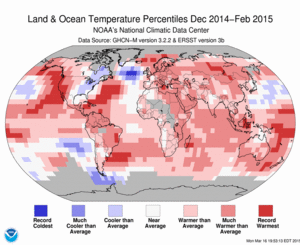Monthly Report Summary Information
The Monthly Report Summary Information is a synopsis of the collection of national and global summaries released each month.
Global Summary Information - February 2015
See Full Report
February 2015 second warmest February on record;
December–February warmest on record
February Arctic sea ice extent third smallest on record
The globally averaged temperature over land and ocean surfaces for February 2015 was the second highest since record keeping began in 1880. Both the year-to-date (January–February) and seasonal (December–February) globally averaged temperatures were record high.
Global highlights: February 2015
- During February, the average temperature across global land and ocean surfaces was 1.48°F (0.82°C) above the 20th century average. This was the second highest for February in the 1880–2015 record. The highest temperature occurred in 1998, at 1.55°F (0.86°C) above average.
- During February, the globally-averaged land surface temperature was 3.02°F (1.68°C) above the 20th century average. This was also the second highest for February in the 1880–2015 record. The highest temperature occurred in 2002, at 3.06°F (1.70°C) above average.
- During February, the globally-averaged sea surface temperature was 0.92°F (0.51°C) above the 20th century average. This was the third highest for February in the 1880–2015 record.
- The average Arctic sea ice extent for February was 370,000 square miles (6.2 percent) below the 1981–2010 average. This was the third smallest February extent since records began in 1979, according to analysis by the National Snow and Ice Data Center based on data from NOAA and NASA.
- Antarctic sea ice during February was 250,000 square miles (21.4 percent) above the 1981–2010 average. This was the sixth largest February Antarctic sea ice extent on record but smallest since 2012.
- According to data from NOAA analyzed by the Rutgers Global Snow Lab, the Northern Hemisphere snow cover extent during February was 230,000 square miles abovethe 1981–2010 average. This was the 14th largest February Northern Hemisphere snow cover extent in the 49-year period of record. Eurasia had its ninth smallest February snow cover extent, while North America had its 20th largest.

February 2015 Blended Land and Sea Surface
Temperature Percentiles February 2015 Blended Land & Sea Surface Temperature Anomalies in °C
Global highlights: December–February 2015
- During December–February, the average temperature across global land and ocean surfaces was 1.42°F (0.79°C) above the 20th century average. This was the highest for December–February in the 1880–2015 record, surpassing the previous record of 2007 by 0.05°F (0.03°C).
- During December–February, the globally-averaged land surface temperature was 2.63°F (1.46°C) above the 20th century average. This tied with 2007 as the highest for December–February in the 1880–2015 record.
- During December–February, the globally-averaged sea surface temperature was 0.97°F (0.54°C) above the 20th century average. This was the third highest for December–February in the 1880–2015 record.
- During January–February, the average temperature across global land and ocean surfaces was 1.42°F (0.79°C) above the 20th century average. This was the highest for January–February in the 1880–2015 record, surpassing the previous records of 2002 and 2007 by 0.07°F (0.04°C).
- During January–February, the globally-averaged land surface temperature was 2.75°F (1.53°C) above the 20th century average. This was the second highest for January–February in the 1880–2015 record. The highest temperature occurred in 2002, at 2.79°F (1.55°C) above average.
- During January–February, the globally-averaged sea surface temperature was 0.94°F (0.52°C) above the 20th century average. This was the third highest for January–February in the 1880–2015 record. For extended analysis of global temperature and precipitation patterns, please see our full February report

December–February 2015 Blended Land and Sea Surface
Temperature Percentiles December–February 2015 Blended Land & Sea Surface Temperature Anomalies in °C
 NOAA's National Centers for Environmental Information
NOAA's National Centers for Environmental Information
